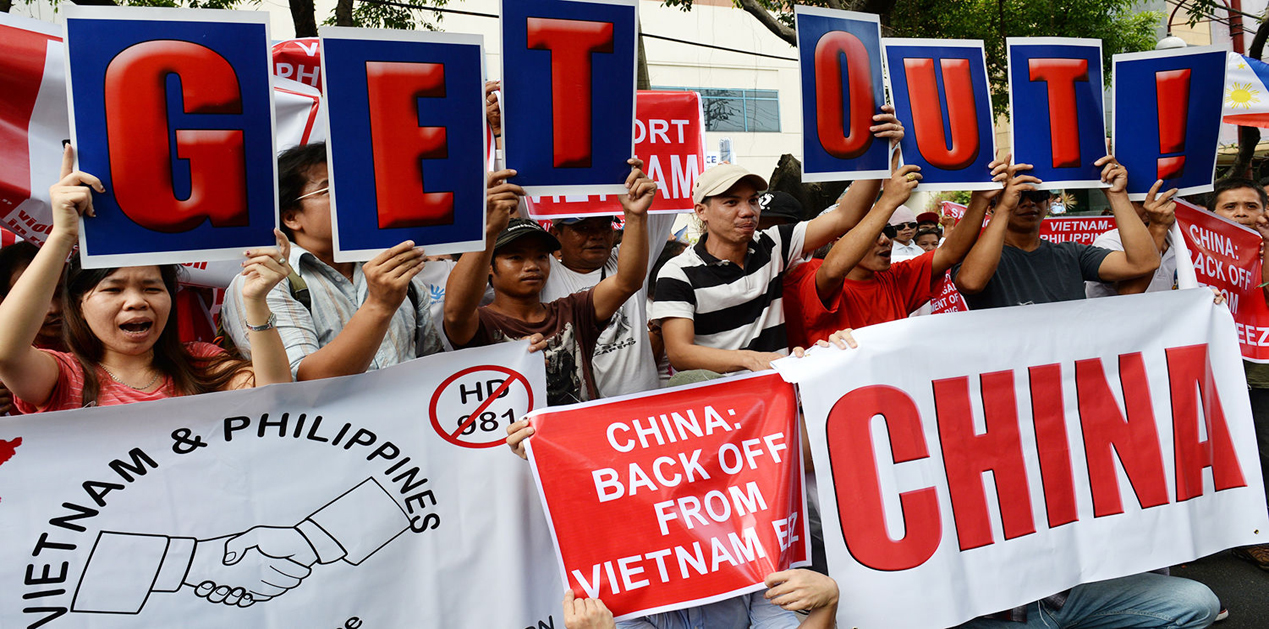The last few weeks witnessed two maritime incidents in the South China Sea. The first involved the Philippines and China, and the second between Vietnam and China. The incidents have once again drawn attention to the complication arising out of disputed territorial claims in the South China Sea and Chinese aggressive posture. The parties at the receiving end- the Philippines and Vietnam have dealt with China's actions differently, which demonstrates the appropriateness of reactive measures - what may work and what could not. It also highlights China’s grey-zone tactics and how dealing with it is a challenge.

Details of the Incidents
The Reed Bank: Philippines and China
On June 9, a Chinese vessel collided with a Philippines fishing vessel named F/B Gem-Ver 1. This incident occurred at midnight at Reed Bank, North of Palawan in the disputed South China Sea. After the incident, it is reported that the Chinese vessel switched off its signals and sailed away, leaving 22 Filipino fishermen to die. The Filipino fishermen stayed afloat for six hours before a Vietnamese vessel rescued them.
China has described the event as accidental, and according to their version the Chinese vessel was threatened by a few Filipino fishing boats and as a result of subsequent maneuvers, it collided with F/B Gem-Ver 1. It added that the Chinese could not rescue the fishermen because Filipino vessels were pursuing it. Beijing accused Manila of politicizing the incident without verification and termed the incident as an ordinary maritime accident.
Manila has disputed this version. Given the actions of the Chinese vessel, as also the fact that the Philippine vessel was anchored, it is widely believed that it was a case of ramming and not a collision. Manila criticised Chinese vessel’s action that left fishermen to die and on 14th June it lodged a formal diplomatic protest with Beijing. Authorities in the Philippines see this as a move by China to discourage Filipino fishermen from the Spratlys, in the same manner that it did in Paracels with Vietnamese fishermen.
Philippines Coast Guard and Maritime Industry Authority set up a committee to investigate the Reed Bank incident and the official report was released on June 20. According to the report, Gem-Ver 1 was at anchorage and it had its anchor lights and flashlights on as per Rule 30 of the International Regulations for Preventing Collisions at Sea, 1972. (COLREG 72). Further, the report mentioned that the sky was clear so there could not have been a situation where Gem-Ver 1 was not visible. It concluded that the Chinese vessel failed to take measures to avoid collision with Gem-Ver 1 and that it ‘failed to render assistance to 20 Filipino fishermen.’ 1 The report does not mention whether it was a case of ramming. A case of ramming needs to be proved to be so - that it was a deliberate act. The report would be submitted to the authorities in China and a joint probe is likely. Senators in the Philippines are opposed to the idea of a joint probe.
The Vanguard Reef: Vietnam and China.
In the second incident, the coast guards of Vietnam and China are in a state of a stand-off in the waters at Vanguard Reef in the Spratly Islands in the South China Sea. A Japanese semi-submersible oil rig Hakuryu 5 was operating in Vietnam’s EEZ as per the contract with Rosneft Vietnam on May 12. The reason for the standoff was that on July 3 a Chinese survey ship Haiyang Dizhi 8 entered in the territorial waters of Vietnam, North of the position of Hakuryu 5 to conduct a seismic survey in the maritime territory controlled by Vietnam. The survey vessel was escorted by two coast guard vessels, equipped with a helicopter and China’s maritime militia. The seismic survey ship had another layer of protection from the PLA Navy ships that were positioned behind the coast guard vessels. According to the latest report, four Vietnamese coast guard ships are patrolling the area.
As the coast guard vessels of the two countries have come face-to-face, a stand-off has taken place. However, according to some independent reports the Chinese oil rig was being defended by commercial vessels. The number of commercial vessels is believed to be 30, out of which 10 have been identified using data from Automatic Identification System (AIS) signals and Open Source Intelligence (OSINT). These commercial vessels, in coordination with the coast guard and the maritime militia vessels, sprayed and rammed into Vietnamese vessels. Reportedly, the civilian captains of the Chinese vessels were awarded 2nd-class merits similar to rewards given to combatants.This points to a trend where Chinese civilian vessels act as an extension of the maritime militia in proclaiming its territory.
Analysis of the Reactions
Both China and Vietnam are fierce when it comes to sovereignty. The Prime Minister of Vietnam, Nguyen Xuan Phu, along with the military leadership was said to be monitoring the situation real-time through video conferencing with the naval crew. Incidents such as these that violate sovereignty would normally cause public anger. However, both governments have been silent on this matter despite the gravity of the situation. There is hardly any media coverage in either country. A spokesperson from Vietnam's foreign ministry, Le Thi Thu Hang stated that Hanoi was determined to peacefully struggle against violations of its sovereignty and that the country was peacefully exercising its jurisdiction through comprehensive measures, as per international law.
China’s foreign ministry spokesperson stated that China was determined to protect its interests in the South China Sea. He also said that China is committed to managing differences through dialogue. This is the standard response from Beijing that the world is accustomed to. The current incident has taken place two months after defence ministers from both sides had agreed to manage disputes amicably and through negotiations. Five years ago China had violated Vietnam’s sovereignty by stationing an oil rig in the Paracels which had seen intense anti-China sentiments in Vietnam. Some suspect that the current standoff may lead to repeat of those sentiments. Hence the government’s endeavor appears to avoid any public protest.
However, behind the scenes, Hanoi has been acting to safeguard its sovereignty. As per the official statement, ‘Vietnamese authorities at sea have been exercising Vietnam’s sovereignty, sovereign rights and jurisdiction in a peaceful, lawful manner to safeguard Vietnamese waters’, and accordingly, the navy and the air force are in full combat readiness and the 162nd Naval Brigade conducted live-fire exercise closer to the site of the incident. This information appeared only in the Vietnamese media and not in any international or English media. This shows that Hanoi does not desire international attention for it may complicate the situation, but at the same time, it has taken steps and disseminated that information to its citizens as a gesture of assurance. If Vietnamese citizens feel that their government is compromising its sovereignty or falling weaker in the face of China’s aggression, it would lead to domestic disturbances. In a communist state, public outrage against the government (in this case if Hanoi is seen as weak before Beijing) is far more serious that an external threat.
The developments in the Philippines in the aftermath of this incident are interesting. Under President Duterte, Philippine's foreign policy has had a volte-face from the traditional orientation and it is evident in how Manila has been demonstrating closeness towards Beijing. But China and the Philippines continue to clash over disputed territories. In 2016 Manila had won the case against Beijing at the International Tribunal at The Hague. However, Duterte did not implement the ruling. Instead, he had a verbal agreement with China that would allow Chinese fishermen to fish in Philippine’s EEZ. Duterte has been widely criticised over his soft stance vis-à-vis China. Politicians in the Philippines have urged him to recall his ambassador to China but Duterte has not done so. Rather, he underplayed the incident calling it a ‘little maritime accident’ and wanted to hear China’s side of the story. Others in the government have issued stronger statements but eventually fell in line with the President. Duterte has re-oriented towards China in the hope of gaining Chinese infrastructure funds and financial support to build the economy. His approach is opposite to the elites in the Philippines who are wary of China. President Duterte may have hoped that his policy will result in desired gains, but unfortunately, it has yielded the opposite result. The Reed Bank episode is fourth such incident during Duterte’s tenure and third instance this year.
There is a pattern in the responses of Manila and Hanoi towards Beijing’s maritime aggression. Both countries have been dealing with the situation by themselves, without any foreign sails to their rescue. Both countries have strived to avoid escalation of the situation. But they vary in their handling of the situation. Vietnam has stood firm whereas the Philippines has sided with China.
Challenge of the Grey-Zone Tactics
Geography and subjective territorial interpretations complicate the South China Sea dispute. What now adds to this complexity is China’s grey-zone tactics. Grey-zone tactics are those actions ‘that [are] coercive and aggressive in nature, but that is deliberately designed to remain below the threshold of conventional military conflict and open interstate war2’. These activities are increasingly employed and are becoming a challenge for targeted countries. It restricts enforcement agencies, there are very few options to confront a grey-zone tactic. One cannot retaliate in the manner that would deter the aggressor, particularly small military powers like the Philippines and Vietnam. Lack of deterrence and retaliatory measures have embolden China to continue its expansion in the South China Sea.
That said, the maritime forces of Vietnam have been able to show resistance to China’s. So far Hanoi has been successful in confronting Chinese aggression. Hanoi has the leadership, fervent nationalism, strategy and the ability to deal with China’s grey-zone actions to safeguard its territory. The same cannot be said about the Philippines where the leadership is inclined to go soft and where the military capabilities are underdeveloped. Philippine’s approach is likely to embolden China even further to pursue its territorial assertion. For its defence, the Philippines relied on its Mutual Defense Treaty with the US which cannot be exercised in this situation. President Duterte demanded that the US should send its 7th Fleet into the South China Sea and fight with China (a statement believed to be said in a sarcastic tone) but incidents such as these do not qualify for military action. China is threatening and intimidating but it is not using force. Therefore, the US cannot initiate military action. It can at best exercise Freedom of Navigation Operations (FONOPS) and politically support the Philippines. China is also testing the US-Philippines ties with such acts and possible signalling to its neighbours that closeness with the US does not stop China from exercising its power.
Further, observers have discovered that Chinese vessels have sailed back and forth between its occupied posts for supplies, and it shows how China’s bases or occupied territories in the South China Sea are supporting its grey-zone tactics. For countries in the India Ocean, like India, this may very well be the beginning of a realisation that Chinese bases and access in the Indian Ocean have the potential to serve China's grey-zone tactics in the future.
Southeast Asia has always demanded that the South China Sea dispute must be addressed multilaterally. The Philippines is an example of how things can shape up if one deals bilaterally with China. It is thus safe to infer that when it comes to dealing with China’s aggression, self-reliance and tough resolve is what makes a difference.
Endnotes
- Palace backs PCG-Marina report on Recto Bank incident, Philippines News Agency, News Information Bureau, Presidential Communication Office.
- Hal Brands, (2016), Foreign Policy Research Institute. Available at https://www.fpri.org/article/2016/02/paradoxes-gray-zone/. (Accessed 19 July 2019)
Image Source: https://www.thetrumpet.com/20992-china-bullying-malaysia-and-vietnam-in-the-south-china-sea











Thank you for a sharp analysis
Post new comment